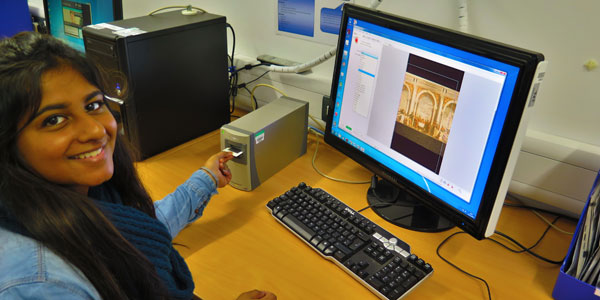
November 17, 2015, by Matt Davies
Volunteering in the DHC 2015; a Historian’s perspective by Depeeka Mistry.
History undergraduate Depeeka Mistry provides some initial impressions of the Digital Humanities Centre after a couple of months of volunteering.
The Digital Humanities Centre is a hub of advanced technology and a haven for every Humanities student, from the outside it is a just a room, but inside it is a Tardis of new technology! However, it is also home to a number of collections of analogue media including a collection of over 80,000 35mm slides, a mini Classics library and -on occasion- even a collection of Ancient coins!
When students come into the DHC the first thing I like to mention is how useful our book scanner is (I’ve even tried to mention it in every conversation I have with history students outside the DHC!). History students are well aware of the struggle of constantly hovering around the Short Loan library waiting for a book to become available then having four hours to attempt to read it before having to hand it back. Well, it is a lot easier to get the book, head on down to the DHC and just scan the chapters you need (ahem…subject to copyright restrictions of course!) You’ll be done within the hour and have your own digital version to read at your leisure!
Another interesting piece of equipment in DHC is the Nikon Super CoolScan Film Scanner. This scanner can be used to transform slides from the aforementioned collection (which include most -if not all -of the world’s most famous pieces of art and architecture and many, many not so well known) into high resolution images on a monitor, which can be used simply for closer examination or included in an essay or a PowerPoint presentation. The slide collection includes images that could come in handy for modules covering anything from the Italian Renaissance, through Tsarist Russia, to 1970s America and beyond! As a modern historian myself, the ability to access these images as primary sources is really useful.
As well as giving you the chance to help your peers further their studies by using the facilities it has to offer, volunteering in the DHC allows you to learn new things. I will admit I had no idea how to properly use a Digital SLR camera. I am now able to set the DHC’s Canon EOS 7D camera up on the copystand and help staff and students to get started producing high resolution photographs of whatever source they may be using. This could be useful for ancient and medieval historians looking to include images of for instance; coins for pieces of coursework, WW1 badges and medals, or even pages from old books that are too delicate for the book or flatbed scanners.
I hope that I have shown that the DHC includes some interesting analogue materials as well as the cutting edge digital technologies for which it is known. Bringing together these resources can provide students with new avenues to explore and help broaden their research interests. The DHC also provides the opportunity for students to develop skills relating to both, which will help them to continue the preservation, archiving and sharing of material that might otherwise be lost.
So… get down there!
DHC is situated in the Humanities building, just turn left at the Taught Courses Office Reception window.
No comments yet, fill out a comment to be the first

Leave a Reply